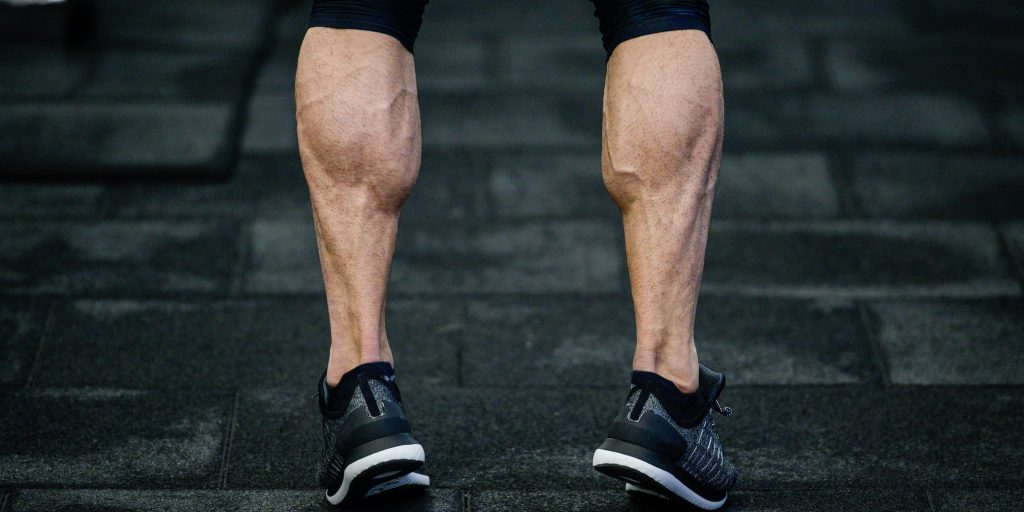
- To do a calf raise, bring yourself up onto your tiptoes and fully contract your calf muscle.
- Though it may vary based on your fitness experience, three sets of 15-20 reps is a good start.
- You can also try doing one-leg calf raises to help balance or using weights to help with strength.
- Visit Insider's Health Reference library for more advice.
If you're looking to build a comprehensive fitness plan, don't forget about your calves. The calf muscles run down the back of the knees down to your ankles. Your calves help you stand up, walk, run, and jump, so it's important to take good care of them.
Calf raises are an excellent way to exercise your calves. Here's how to do them and their benefits.
How to do calf raises
Calf raises are simple to do, and they can be beneficial when you're looking to build strength in your legs. Justin Meissner, NASM certified trainer at Innate Strength Training says to follow these steps to do a basic calf raise:
- Stand with feet shoulder-width apart on a flat surface.
- Raise your heels and stand on the balls of your feet
- Raise up as high on your tip-toes as you can to fully contract the calf muscles.
- Lower yourself down slowly with control back down to a regular standing position.
The ideal amount of sets and reps can vary based on the individual, but around three sets of 15-20 reps is a good place to start, says Meissner.
There are some variations of calf raises you can do if you have more specific goals.
Weighted calf raise
To make the standard calf raise more challenging, Meissner says you can add weights. Follow these steps:
- Hold onto two weights (one in each hand). You can use whatever you prefer –– dumbbells, kettlebells, or even water jugs.
- Stand with feet shoulder width apart on a flat surface.
- Press yourself onto your toes and raise the heels of your feet off the ground.
- Raise up as high as you can on your tip-toes as you can to fully contract the calf muscles.
- Lower yourself down slowly and with control back down to a regular standing position.
When using weights, you should do less reps. Meissner says to aim for around three sets of eight to 12 reps.
Single leg calf raises
If you have one leg that is significantly stronger than the other, or, if you want to challenge your balance, you can opt for single-leg calf raises, says Danny Lehnert, DPT, physical therapist and certified strength and conditioning specialist at Eclipse Wellness.
Lehnert says to follow these steps:
- If you are trying to get stronger, hold onto something (like a wall or chair) for support. If you want to work on balance, do this unsupported.
- One foot/leg should stay firmly planted on the floor. Bend the opposite leg so the other foot is comfortably off the ground.
- Press yourself onto your toes and raise the heels of your feet off the ground with the standing foot.
- Lower yourself down slowly and with control back down to the one-legged regular standing position.
Do around two to three sets of eight to 12 reps and then repeat on the other leg.
Calf raises on a step
Utilizing a step can help promote a greater range of motion, which can help with flexibility as well as strengthen the tendons, Lehnert says. Follow these steps:
- Stand on the edge of a step or raised surface with the front half of your feet on the step and your heel hanging off of the edge.
- Press yourself onto your toes and raise the heels up.
- With control, slowly drop your heels down as low as you can comfortably go.
Try doing three sets of eight to 12 reps.
Benefits of calf raises
Since your calves are so important to your overall mobility, working them results in various benefits such as:
They target an often-overlooked muscle: When training the legs, many exercises tend to overlook the calves. Calf raises are a way to really target this area. "Traditional squats and lunges do a good job of developing your entire leg, but sometimes the calf can be neglected and it is a crucial muscle," says Lehnert.
They help with everyday movement: Lehnert says calf raises help strengthen the gastrocnemius and soleus muscles, which are crucial when you walk or run. "Most of the force for walking and running comes from your calf muscles and your hip flexors, so having strong calves is a must for daily activities that involve walking," says Lehnert.
They can improve balance: The calf works to stabilize the muscles of the ankle, which can improve balance and stability, which also results in an added benefit of decreased risk of injury, says Meissner.
They can strengthen your Achilles tendon: Regularly practicing calf raises can strengthen the Achilles tendon, which is the tendon that connects your heel and calf, says Meissner. This can help prevent injury to the tendon.
Insider's takeaway
Calf raises are a simple exercise you can do at home that can be modified to meet your needs and help you reach your fitness goals. Strengthening your calves can help build strength, improve your day-to-day movements, and prevent future injuries.
